|
|
| Black Moissanite |
GAAJ-ZENHOKYO Laboratory
Hiroshi Kitawaki(FGA, CGJ) |
|
We have recently encountered quite a few cases of black diamond jewellery containing synthetic moissanite. Inspection under magnification with a gemmological microscope can distinguish these materials, and an X-ray transparency test (radiograph) is useful for jewellery pieces set with many gemstones. To identify and determine individual suspicious stones, laboratory techniques such as fluorescent X-ray analysis or microscopic Raman spectral analysis are required.
|
Background
gBlack diamondsh have been set in jewellery since the late 1990s and jewellery items set with these small stones are still popular today. This material can be one of the following:  a natural colour stone, a natural colour stone,  an irradiation treated stone, and an irradiation treated stone, and  a stone heated under high temperature (please refer to GEMMOLOGY September 2000 and November 2004 issues for details). In todayfs market, mainly circulated are the stones mentioned in category no a stone heated under high temperature (please refer to GEMMOLOGY September 2000 and November 2004 issues for details). In todayfs market, mainly circulated are the stones mentioned in category no 
Heat treatment using high temperature is performed on very poor quality single crystal natural diamonds, or white to grey polycrystalline diamonds, by reducing (oxygen-poor) environment to graphitise the material to make them appear black. Most black diamonds used in jewellery items today have been heat treated in high temperature in such a manner, however, some black diamonds may have been irradiation treated. Black cubic zirconia may also be mixed in the stones (please refer to GEMMOLOGY May 2005 issue for details) which makes the identification of gblack diamondsh more complicated. Furthermore, additional difficulty to the identification was caused by larger quantities than use to appear before of synthetic moissanite mixed in the gblack diamondh jewellery (photo 1).
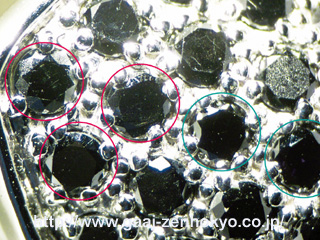 |
|
Photo-1F
|
An example of a gblack diamondh jewellery containing moissanite; red circle indicates moissanite, green circle indicates irradiation treated diamond, and others are high temperature-heat treated diamonds.
|
|
|
Magnification Test
Observation under magnification is important to identify gblack diamondsh. Inclusion observation of gemstones that are black is difficult because the stones are opaque and each stone needs to be thoroughly inspected individually under a strong fibre optic light. Natural black diamonds typically contain black needle-like inclusions (photo 2) or irregular-shaped dark inclusions scattered throughout the stone (photo 3). High temperature-heat treated diamonds contain minute graphite that are closely packed and appear perfectly black even under magnification. However, the difference in density of the packed graphite will be seen as different shades along the crystal structure (photo 4) or a concentration of graphitisation will be seen in the fracture reaching the polished surface (photo 5).
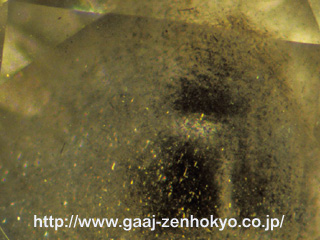 |
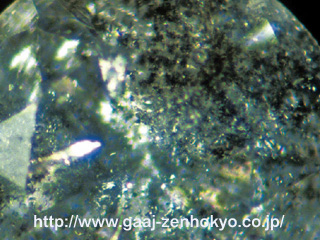 |
|
Photo-2:
|
Black needle-like inclusions in a natural black diamond.
|
|
|
Photo-3:
|
Irregular-shaped dark inclusion in a natural black diamond.
|
|
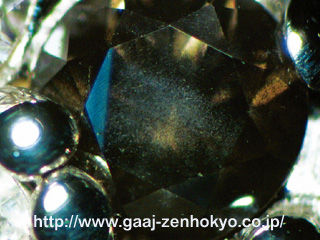 |
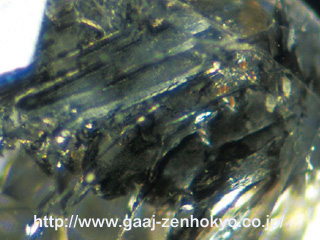 |
|
Photo-4:
|
Difference in shades shown by graphite concentrated along the crystal structure of a diamond.
|
|
|
Photo-5:
|
Graphite concentrated in a fracture that is reaching to the polished surface of a high temperature-heat treated diamond.
|
|
Contrary to this, black moissanite is solidly opaque and does not show fine graphite concentration characteristic as in high temperature-heat treated diamonds (photo 6). However, rough polish may result in facet surfaces appearing as if graphite particles are assembled and careless observation will mislead its identification as a high temperature-heat treated diamond (photo 7). Moissanitesf high degree of hardness also prevents facet edges being blunt, like CZ, and doubling or needle-like inclusions that are characteristic to moissanite cannot be confirmed (please refer to GEMMOLOGY February 1999 issue for details). Moissanite, which readily crystallizes from the silicon and carbon dissolved in the molten iron. The resulting moissanite crystals are nearly black and opaque due to their iron content.
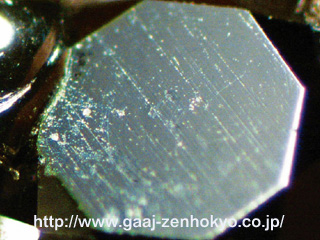 |
 |
|
Photo-6:
|
No concentration of graphite is confirmed in a black moissanite.
|
|
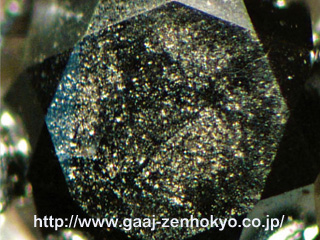 |
 |
|
Photo-7:
|
Comparison of faceted surfaces of black moissanite (left) and high temperature-heat treated diamond (right). They may be confused if moissanite has rough polish on the surface, which will give an appearance of concentrated graphite.
|
|
|
|
|








